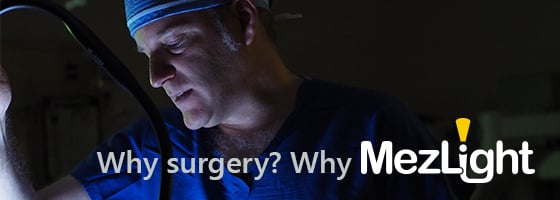I was born in Princeton, New Jersey, and spent the first 21 years of my life there. I have two brothers, Ben (a famous writer, who has written 21 books, the most well-known being the book behind the movie The Social Network and the movie 21), and Jon, a radiologist. My dad was an electrical engineer, but when I was in third grade, he went back to medical school. When he began his residency, I used to love sitting at the dinner table listening to his stories about the patients, and perhaps that was when I became interested in the field of medicine. I really didn’t know anything about surgery, other than really loving the character Hawkeye Pierce in Mash. I loved the way he mixed humor with complex surgery – a coping mechanism I use to this day.

When I went to college, I majored in Russian Language and Literature. I never thought I would have a career related to that, but I loved Russian literature, found their history and politics fascinating, and enjoyed learning the language. When I entered medical school at Cornell University Medical College in Manhattan, I thought I would go into pediatric oncology – I loved kids, and thought if I could make them laugh when they were sick, perhaps that would be something wonderful.
This may sound clichéd, but I really became fascinated with surgery on my first day of the surgical rotation. I showed up at 4:30 in the morning, pre-rounded, and then rounded with my team. It was when I met my chief resident at 7 am that I found out I was on call that day. I spent the entire day in the operating room, trying not to cut sutures too long or too short (which of course was impossible). At 10 at night, I found myself in a bowel obstruction, and I realized I hadn’t eaten or drank anything all day (which was good, because I never had to take a bathroom break!) I almost passed out in that surgery, but somehow managed to stay on my feet. Around midnight, as we were finishing up, my resident told me to go next door to scrub in on another case. I really wanted to go home, but being the good medical student, I went in the room.
It was a kidney transplant from a deceased donor. I’ll never forget that moment in the middle of the night, with the classical music playing and the surgeon and resident confidently releasing the clamps on the kidney, when the kidney turned pink before our eyes, and minutes later, urine began streaming out onto our hands! I was absolutely blown away! At that moment, I knew I would do whatever I had to do to be the one to perform an operation like this. I loved the challenge of it, the idea that if I worked really hard and pushed myself, maybe I could learn how to do this myself. I knew someone had just died to provide this incredible gift. I knew very little at that time about what other organs could be transplanted like this, but I was ready to find out.
"crown of thorns"
One thing I didn’t know about surgery at that time, was how hard it can be on your body. Throughout all of our training, I think we all try so hard to learn the operations, help our attendings, put ourselves in whatever position we need to to retract perfectly, tie, cut, and get the lighting where it needs to be. I began wearing a headlight for every open case when I was a third year resident. I recognized how bad the lighting was without a headlight, and how happy my attendings would be when I could perfectly illuminate the field. It took me about two years to master the headlight – in the beginning I would often hold my head at bizarre angles and shift my eyes as necessary because I didn’t have the light adjusted perfectly, or perhaps because I bumped my light into the attending and it shifted ever so slightly. I also remember the headaches I would get when I put that crown of thorns on too tightly. As a transplant fellow, I would wear the light for hours upon end as we slogged our way through complex livers or kidney pancreas transplants. I would re-adjust it with a green towel after it moved, and then go right back to operating, and I often wondered if I was putting my patient at risk for infection. I also always hated picking up a hastily cleaned headlight at the beginning of an operation, feeling the moisture of sweat from the last wearer on my forehead!
On the first day that I became an attending, I stopped wearing a headlight. I am lucky enough to work with fellows, who are already well-trained in their own right. I have them wear a light on every case. It’s not a perfect solution – despite their level of training, it’s surprising how often their light doesn’t actually shine in the field we are working in. And every time the door opens or the phone rings, I find myself in the dark, often right as I am trying to sew a bleeder or anastomosis. It is so frustrating…but not frustrating enough to go back to wearing the light. Over the years my body has broken down. I have a theory that the human body was designed to function at a high level until 40, and after that you are just trying to squeeze out what you can! (I am at least half-joking). I never had any aches and pains before 40, was always a runner and would work out when I could. But over the last decade I have suffered from back, neck, and knee pain. My wife is a vascular surgeon, and she continues to wear the headlight. She likes to be in control (don’t we all?). She finds it too frustrating to let someone else wear the crown and light up the side of the patient while you are working in the belly. Her neck is aching every night after long cases.
"snake light for the OR"
About five years ago I started to wonder why in the world we allow ourselves to wear the light on our heads. We are like packhorses, willing to put up with anything because of our culture of being tough and not complaining. I looked into all the retractor-based lights, but I really didn’t like any of them. They were either too flimsy, or they got in your way when you operated. My number one goal is to not change the way surgeons operate. We all train so hard to be as perfect as we can be, developing our systems for operating safely and in control. I see the retractor as central to setting up a case well, and I would never want to give up space on my retractors for a light. But the side bar is a different story. I realized a while back that perhaps there is space on the side bar to support a snake-light. It could be sterile, controlled by the surgeon, and moved in and out as necessary when lighting is needed. The biggest challenge I did see was figuring out how to do this without it getting in the way. Surgery is so physical – we turn our bodies in different angles as we work, and I didn’t want to inhibit that. But as I was looking at different retractors, I saw the martin arms. These are not often used around the country, but we do have them in Wisconsin. The beauty of these retractors is they hook on the side rail, but bend over the patient to bring the actual retractor to the midline, which allows them to stay out of the surgeon’s way. That discovery started me on the path to developing the MezLight – a path that took more than five years and numerous designs and prototypes. But it has finally arrived.
The goal of the MezLight is to provide light as good or better than the headlight where you need it when you need it, without having to wear it on your head. I don’t want to change how surgeons operate. I want to enhance how they operate. I want us to feel better while we operate; less frustration from being in the dark, less pain as we can focus more on our positioning and ergonomics. I want my wife’s neck to feel better. I want to stop injuring my fellows and trainees! I can’t tell you how many times I have been told by other surgeons that “I hate the headlight but I wear it on every case!” Even worse, one colleague recently told me she just refused to wear it. I asked her how she could see when deep in the belly. She said she couldn’t! Well, now she can!
I see the MezLight as a surgical instrument. Designed by a surgeon for surgeons. We control it, we can adjust it throughout the case and we don’t wear it on our heads.


